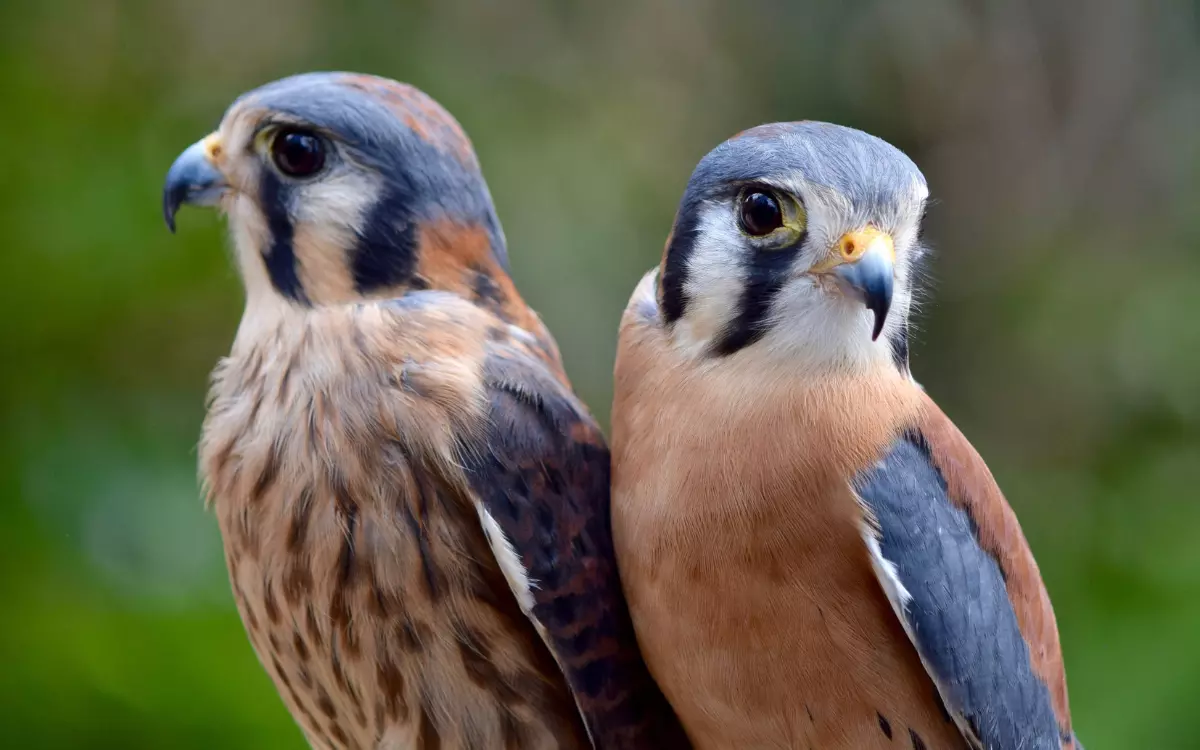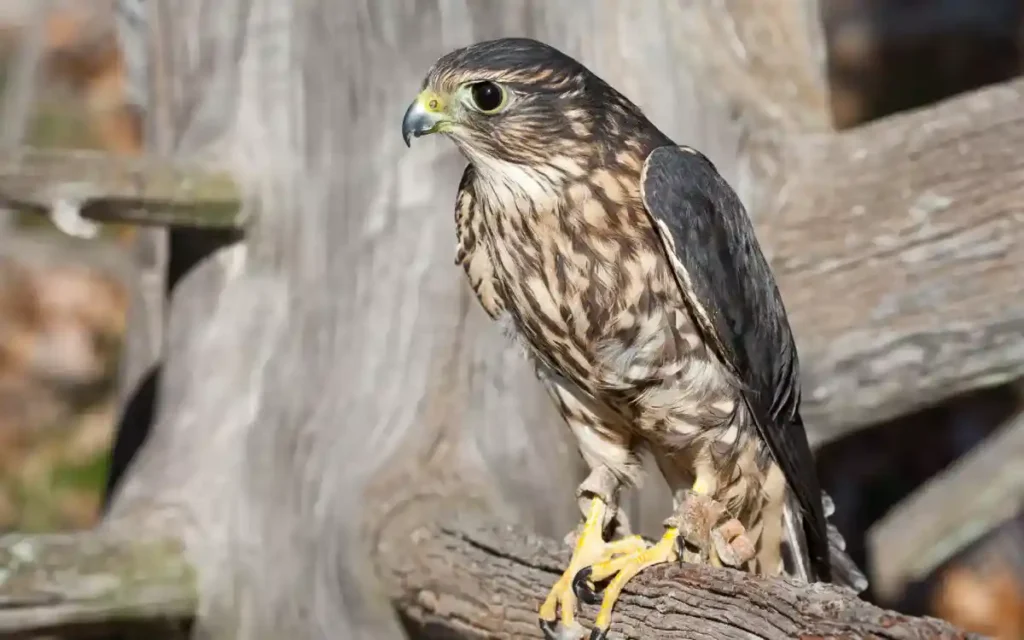South Carolina Falcons: Photos,Call

We have Found the Most common 4 South Carolina Falcons: the Peregrine Falcon, the American Kestrel, the Merlin, and the Prairie Falcon, they are normally seen in there and they each have special characteristics and habitats.
List of 4 South Carolina Falcons
1. American Kestrel:

The American Kestrel, often referred to as the “sparrow hawk,” is a bird of captivating beauty and remarkable adaptations. Despite its diminutive size, this falcon boasts an array of characteristics that make it an intriguing subject for bird enthusiasts.
Habitat and Range: American Kestrels are versatile when it comes to habitat selection. You can spot them in a variety of settings, including open fields, grasslands, farmlands, and even urban areas. They are known for their adaptability, which has allowed them to thrive in diverse environments.
Dietary Preferences: These falcons have an eclectic diet, primarily consisting of insects, small mammals, and occasionally small birds. Their hunting style is distinct, often characterized by hovering in the air and then diving swiftly to capture prey. This hovering behavior is a sight to behold, as they lock their gaze on unsuspecting insects or rodents.
Breeding Behavior: When it comes to breeding, American Kestrels are known for their fascinating courtship rituals. During the courtship display, the male performs aerial acrobatics, such as somersaults and hovering, to impress the female. Once a pair bonds, they select a suitable nesting site, often in tree cavities, nest boxes, or abandoned nests of other birds.
Conservation Efforts: In South Carolina, conservationists have recognized the importance of protecting American Kestrels. Loss of open spaces due to urbanization and habitat destruction poses a threat to their populations. Conservation initiatives involve setting up nest boxes to provide safe breeding sites and conducting research to better understand their behavior and needs.
- Latin name: Falco Sparverius
- Length: 9 – 12 in (23 – 30 cm)
- Weight: Around 3.9 oz (111 gm)
- Wingspan: 20 – 25 in (51 – 64 cm)
CALL:-
2.Merlin:

Merlins are aptly named for their incredible speed and agility, making them a challenging subject to observe and study. These falcons have several noteworthy characteristics that set them apart.
Distinctive Appearance: Merlins are striking birds with a compact build. They exhibit sexual dimorphism, with females being larger and more heavily streaked than males. Their dark eyes and distinct facial markings make them easily identifiable.
Migration Patterns: Merlins are known for their migratory behavior. They undertake long-distance journeys during their seasonal migrations, and South Carolina is fortunate to be part of their migratory route. Birdwatchers can spot them during the spring and fall migrations when they pass through the state.
Hunting Techniques: Merlins are skilled hunters, preying on small birds and occasionally insects. They employ a mix of speed and stealth in their hunting strategy. Often, they will surprise their prey with sudden bursts of speed, ensuring a successful capture.
Conservation Status: Understanding the conservation status of Merlins is crucial for their protection. While not endangered, monitoring their populations and habitats remains essential, especially in regions like South Carolina where they are transient visitors.
- Latin name: Falco columbarius
- Length: 11 – 13 in (28 – 33 cm)
- Weight: 7.4 oz (210 g)
- Wingspan: 23 – 26 in (58 – 66 cm)
CALL:-
Read also:-
3. Peregrine Falcon:

The Peregrine Falcon, renowned as the fastest animal on Earth, is a true marvel of nature. With breathtaking stoops and incredible adaptations, they are among the most awe-inspiring birds of prey.
Speed Records: Peregrine Falcons are famed for their stoop, a high-speed dive used to capture prey. During these stoops, they can reach speeds of up to 240 miles per hour (386 kilometers per hour). This astounding velocity is essential for capturing agile birds mid-flight.
Anatomical Adaptations: To achieve such extraordinary speeds, Peregrine Falcons have evolved remarkable anatomical adaptations. Their streamlined bodies, strong wings, and sharp talons are finely tuned for high-speed pursuits.
Nesting Habits: Peregrine Falcons exhibit interesting nesting habits, often choosing cliff ledges or tall buildings as nesting sites. In South Carolina, where urban areas offer suitable nest locations, conservationists have worked diligently to create safe nesting environments.
Recovery Efforts: Peregrine Falcons faced a critical decline in the mid-20th century due to the effects of pesticides like DDT. However, intensive conservation efforts, including captive breeding and release programs, have led to a remarkable recovery. South Carolina has played a significant role in this success story, with thriving Peregrine Falcon populations.
- Latin name: Falco peregrinus
- Length: 16 – 20 in (41 – 51 cm)
- Weight: 52.91 oz (1499 gm)
- Wingspan: 43 – 46 in (109 – 117 cm)
CALL:-
4.Crested Caracara:

While not a falcon in the strict taxonomic sense, the Crested Caracara shares some characteristics with falcons and is an exciting bird to encounter in South Carolina.
Distinct Appearance: Crested Caracaras are striking birds with a unique appearance. They are often mistaken for eagles due to their size and striking black-and-white plumage. Their distinctive crest and facial markings make them easily recognizable.
Habitat and Behavior: In South Carolina, Crested Caracaras are a rare and sporadic sight. They prefer open country, pastures, and grasslands. They are opportunistic scavengers, often feeding on carrion, but they are also skilled hunters of small mammals, reptiles, and birds.
Year-round Residents: Unlike some migratory birds, Crested Caracaras are non-migratory, which means they can be spotted in the state throughout the year. However, their sightings are infrequent, adding to their mystique.
- Latin name: Caracara cheriway
- Length: 20 – 25 in (51 – 64 cm)
- Weight: around 33.6 oz (952 gm)
- Wingspan: 45 – 48 in (114 – 122 cm)
CALL:-
Here are some FAQs :
Q: What kind of falcons live in South Carolina?
Ans: South Carolina is home to several falcons, including the Peregrine Falcon, American Kestrel, and Merlin.
Q: What kind of hawks live in South Carolina?
Ans: In South Carolina, you can find Red-tailed Hawks, Red-shouldered Hawks, and Cooper’s Hawks among others.
Q: What is the difference between a kite and a falcon?
Ans: Kites are generally larger and less agile in flight compared to falcons, which are smaller and faster with pointed wings.
Q: Is a hawk bigger than a falcon?
Ans: Yes, most hawks are larger and bulkier than falcons, which tend to be smaller and more streamlined.
Q: Is a kite a falcon?
Ans: No, a kite is not a falcon. Kites belong to a different group of birds and are generally larger and less agile in flight.
Q: Are the Golden Eagles in South Carolina?
Ans: Golden Eagles are very rare in South Carolina and are mostly seen during migration or in winter in mountainous areas.
Conclusions:
South Carolina Falcons are incredible birds, each with special abilities and environments. From fast-flying Peregrines to small but mighty Kestrels, these falcons add beauty and excitement to South Carolina’s wildlife. They are truly a birdwatcher’s pleasure.






